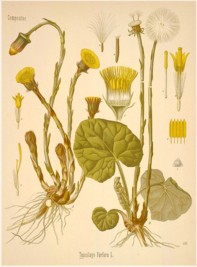Colonizing Coltsfoot
By Audrey Stallsmith

. . .his inherited delight to wander through the fields in search of foxglove and dandelion and coltsfoot began to wear to him the character of a temptation.
Silas Marner, George Eliot
My earliest memories of coltsfoot are pleasant ones. In March my siblings and I often hiked to the site of an old farm to see if the heirloom daffodils were yet in bud. Nothing else remained of the homestead except a few mossy rectangular rocks from the springhouse, studding a stream thick with watercress.
The daffodils were an early-blooming double type, probably Van Sion, and signified the arrival of spring to us. And, as often as not, thrusting up through the dead leaves around their ankles would be the round yellow blooms of coltsfoot.
I always assumed it to be a native wildflower, but have since learned that colonists introduced the plant to this continent. And it obviously adapted quite happily to its new surroundings!
So prolific is coltsfoot that Sir John Hill advised we "stop a moment and adore the goodness of divine Providence which makes the best things the most common. The Segroms which can do only mischief are found in but a few places: this so full of excellence grows at our doors and we tread it everywhere under our feet."
Coltsfoot was once so popular in Europe as a medicinal treatment for coughs and lung problems, such as asthma and bronchitis, that French pharmacists painted its flowers on their doorposts. Herbalists even prescribed the smoking of the herb to those afflicted with breathing ailments--a treatment we would now consider questionable at best!
But modern science has discovered that coltsfoot, taken in less irritating ways, does relieve coughing. According to Michael Castleman's The Healing Herbs, the plant "increases the activity of the microscopic hairs in the breathing tubes that move mucus out of the respiratory tract" and also "suppresses the platelet activating factor that triggers asthma attacks."
American colonists sometimes wrapped persons afflicted with whooping cough in blankets that had been soaked in a coltsfoot infusion. Its official name, Tussilago farfara, derives, in fact, from the Latin tussis ("cough") and agere ("to drive"). Farfara may, depending on whom you believe, be an ancient name for white poplar or come from "farina" or the Spanish en farfara ("unfinished").
Any of those would be appropriate. Gerard, in his 1597 Herball or General Historie of Plantes describes coltsfoot as having "many white and long creeping roots, somewhat fat, from which rise up naked stalkes (in the beginning of March and Aprill) about a spanne (9 inches) long, bearing at the top yellow floures, which change into downe and are caried away with the winde: when the stalke and seed is perished, there appeare springing of out the earth many broad leaves, greene above, and next the ground of a white hoarie or grayish colour, fashioned like an Horse foot. . ."
So the plant's leaves are a similar shape to poplar's and it has a farina of sorts. Also, since the flowers appear before the leaves, it could be considered "unfinished" at that point!
Due to that early bloom, coltsfoot was once known as filius ante patrem ("the son before the father"). Some of its other nicknames include ass's foot, British tobacco, bullsfoot, clayweed, clutterclogs, coughwort, donnhove (donn being an ancient word for "horse"), fieldhove, flower velure, foal's foot, foalswort, hallfoot, horsefoot, horsehoof, sweep's brushes, and wild rhubarb.
In his Encyclopedia of Fruits, Vegetables, and Herbs, John Heinerman recommends that those suffering from congestion inhale the steam from an herbal tea that includes the herb and two others-yarrow and plantain. Jethro Kloss's Back to Eden suggests applying coltsfoot-soaked cloths to the chest and throat or snuffing the powdered leaves of the plant. It is also supposed to soothe sore throats and skin inflammations such as pimples and boils.
The "excellence" of the herb has recently come into dispute, however, since it contains the same pyrrolizidine alkaloids that have marred comfrey's reputation. Those toxins can cause liver damage when consumed in large amounts.
But, as James Duke points out in The Green Pharmacy, "data published in the journal Science by noted biochemist Bruce Ames. . .indicate that comfrey leaf tea is less carcinogenic than an equivalent amount of beer." So we can probably assume that the dangers of coltsfoot have been exaggerated too.
Herbalists do recommend that the down from the leaves be strained out of all infusions, lest those imbibing them be more irritated than soothed. In the past that down was often used as tinder, while coltsfoot's silky seed fluff stuffed pillows and mattresses. Birds still employ it to line their nests.
In the Language of Flowers, coltsfoot declaims, somewhat mysteriously, "justice shall be done to you." Scots once believed that a prolific patch of the herb indicated an abundance of coal underneath it. And the flying of the plant's fluff on a still day presaged rain. Bavarian peasants traditionally burned garlands of coltsfoot as part of their Easter celebration. Perhaps its sudden blooms symbolized resurrection to them.
Those flowers only open to the touch of sunlight, and remain closed at night or under cloudy skies. Maybe that's why, on those long ago March days, we kids sometimes saw them and sometimes didn't. But we always knew the cheerful little flowers were under there somewhere and would return, as surely as the sunshine or springtime itself.
Image is from Köhler's Medizinal-Pflanzen by F. E. Kohler, courtesy of the Missouri Botanical Garden Library.








